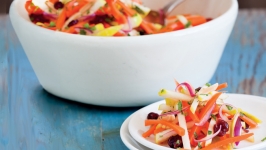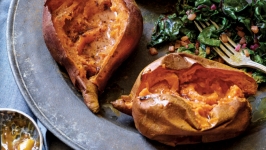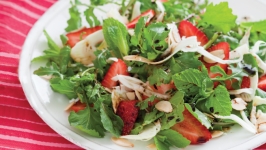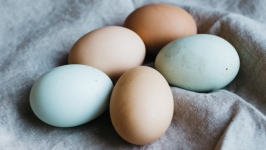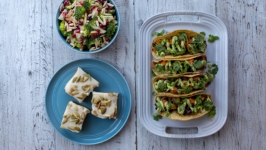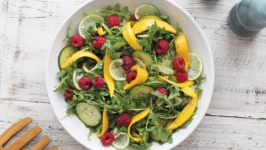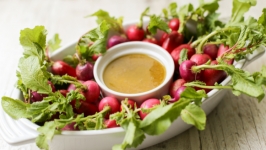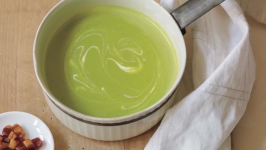Paint Your Plate : A Colorful Way to Calm Inflammation and Eat Deliciously
Are you curious what the deal is about inflammation? And what you can eat to cool it down? It’s actually super simple.
Inflammation can be appropriate and helpful when it’s in response to an acute injury. The swelling and redness surrounding a cut on your finger are visible evidence of the body’s troops rushing to heal injury and prevent infection.
But what if inflammation gets out of control? Bacterial or viral infections, chemicals, trauma, stress, an unhealthy balance of gut bacteria and certain foods, for example, can irritate tissues and cause the immune system to overreact. Chemicals from white blood cells are released into the bloodstream and tissues to protect your body, creating warmth and redness and potentially causing rather than preventing health problems, including big-ticket diseases such as autoimmune conditions and cancer.
Chronic inflammation is like having dust bunnies under the bed. You can’t see them, but eventually that fluff starts creeping out into the center of the room. When you see them, you can sweep them up and maintain some semblance of order. The cause and effect is as clear—our bodies collect invisible “dust bunnies” that build up over time, irritants that can make us feel uncomfortable and out of sorts.
They masquerade as brain fog, headaches, digestive distress, extra belly fat around the waist, fatigue, skin problems, puffy bags under the eyes, sinus problems, joint pain, to name a few. The good news is you can heal many of these symptoms and discomforts by shifting what you eat. Turn your black-and-white food world into Technicolor!
There’s no need to adopt rigid restrictions, nor follow a specific “anti-inflammatory diet.” The solution is much easier and much more fun than that! Just learn the foods to adopt, so you have a menu of options to play with and explore.
What foods to turn to? Include lots of flavonoids, a group of phytochemicals that are important components of many fruits and vegetables and the most powerful antioxidants and anti-inflammatory agents in our diet. So it’s truly easy—just fall in love with vegetables! There are lots of beautiful options for your palette; think about it as painting your plate with color.
When you pack every plate with color, you are incorporating lots of flavonoids—or, as I like to say, superpowers! Feel free to step out of “diet” mode and into beauty and flavor. The Greek word dieta has as much to do with lifestyle as with food. By playing with color and choosing simple ways of preparing foods, it is easy to incorporate anti-inflammatory, healthy nourishment into your life.
Find additional inspiration for colorful and healthy recipes and ideas in these two cookbooks by Rebecca Katz.
Expand your food-color palette
Green: Kale, arugula, avocado, bok choy, lettuces, chard, collards, beet and turnip greens, dandelion greens, broccoli, Brussels sprouts, Romanesco broccoli, snap peas, cabbages, asparagus, artichokes, watercress, fennel, green tea, parsley, cilantro, basil, rosemary, leeks, scallions, limes and celery. There are so many options.
Purple & red: Beets, raspberries, eggplants, strawberries, blueberries, blackberries, purple potatoes and sweet potatoes, red cabbage, purple cauliflower, apples, tomatoes, red and purple peppers, pomegranates, cherries, watermelon, grapes, radishes, cranberries, purple and red carrots, red pears and purple kohlrabi.
Yellow, orange & gold: All the winter squashes and many summer squashes, oranges, lemons, yellow and orange peppers and tomatoes, corn, carrots, apricots, peaches, nectarines, cantaloupe, papaya, mango, orange cauliflower, French melons, sweet potatoes, persimmons, olive oil, turmeric and saffron.
Now, mix them on your plate! By mixing and matching colors in your meals, how dynamic they will look! Mix greens with orange squash in the winter, or radishes in the spring, or tomatoes with a beautiful green salad in the summer. And of course, accessorize with spices. Garlic is a major anti-inflammatory food.
Inflammation-Busting Food Challenge:
Cook for a Week with Color!
Whether you’re pondering the produce at the grocery store or browsing your farm market, what’s fresh and colorful and appeals to your senses and taste buds?
Try these interesting combinations:
Avocado toast: Try it with arugula and radish. Smoosh the avocado, and then add some arugula and sliced red radish. The dark green and slightly bitter arugula pairs perfectly with the beautiful fat of the avocado and the crunch and color of the red radish.
Sweet Potatoes: Add sautéed chard or your favorite dark leafy green. Sprinkle with pomegranate or dried cranberries for a pop of color and a sweet flavorful bite.
Blueberries: Don’t underestimate the power of adding blueberries to a salad or an abundance bowl, making the dish not too sweet, but surprising to your taste buds.
Salads: Here’s a refreshing salad idea: Mix baby greens with mint, fennel and strawberries. Try celery with apples and walnuts and voilà!, a healthy Waldorf salad. Top your favorite greens with colorful roasted vegetables.
Slaws: Shred some red cabbage and carrots and sprinkle them with herbs (mint, parsley, cilantro), or my favorite—shredded red cabbage and shredded beets.
